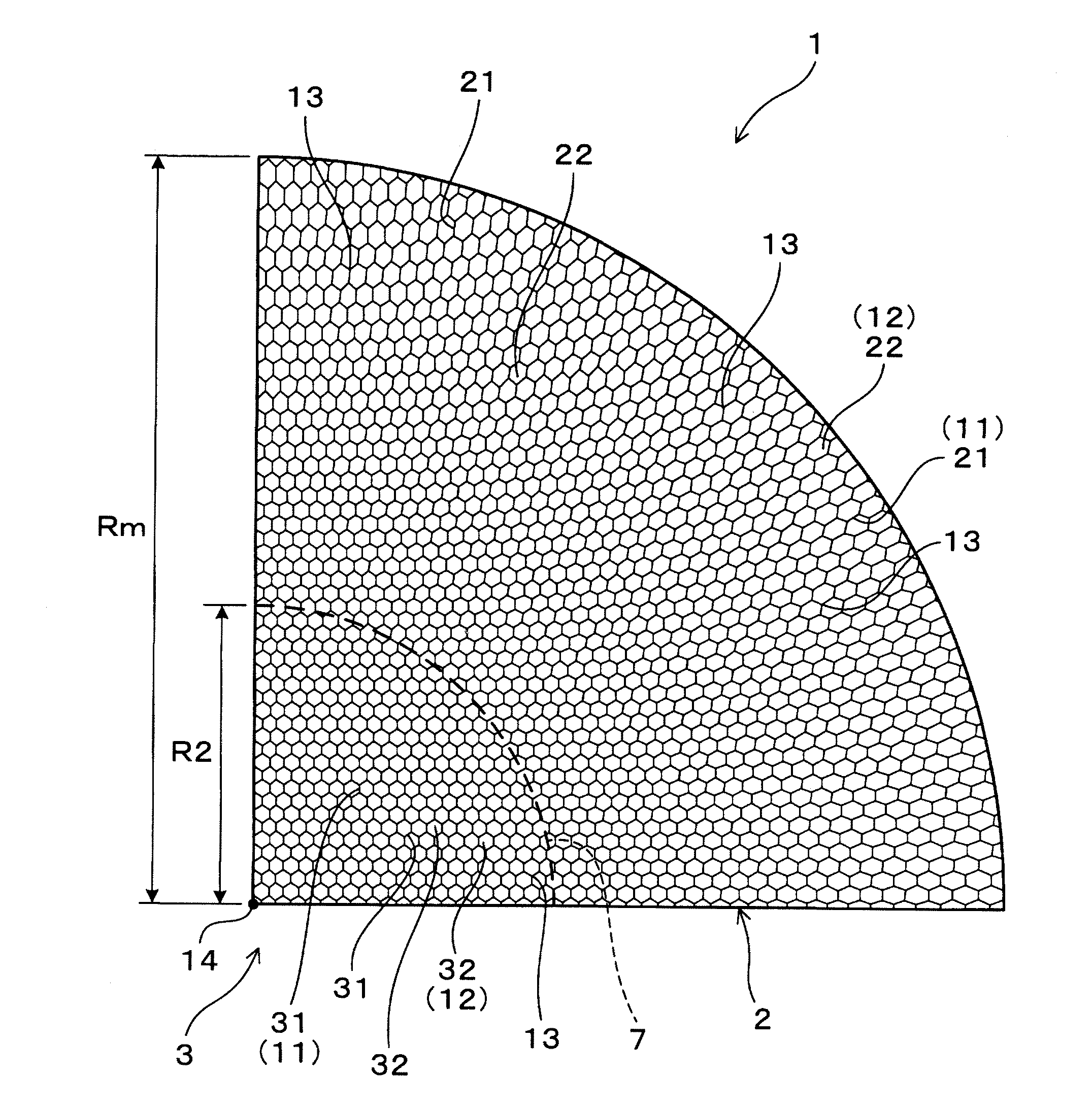Honeycomb structure body and method of designing honeycomb structure body
- Summary
- Abstract
- Description
- Claims
- Application Information
AI Technical Summary
Benefits of technology
Problems solved by technology
Method used
Image
Examples
first exemplary embodiment
[0036]A description will now be given of the honeycomb structure body and the method of designing a structure of the honeycomb structure body according to a first exemplary embodiment with reference to FIG. 1 to FIG. 5.
[0037]FIG. 1 is a cross sectional view showing a structure of the honeycomb structure body 1 according to the first exemplary embodiment in a radius direction which is perpendicular to an axial direction of the honeycomb structure body 1.
[0038]As shown in FIG. 1, the honeycomb structure body 1 according to the first exemplary embodiment has a plurality of cell walls 11, 21, 31 and a plurality of cells 12, 22, 32. Each of the cells 12, 22, 32 is surrounded by the cell walls. Although each of the cells 12, 22, 32 has a straight tubular shape, and a cross section of each has a hexagonal shape shown in FIG. 1, it is acceptable for each of the cells 12, 22, 32 to have a cross section of another shape, for example, a circular shape, a rectangle shape, a square shape, etc. T...
second exemplary embodiment
[0080]A description will be given of the structure of the honeycomb structure body 1 according to the second exemplary embodiment with reference to FIG. 7 and FIG. 8.
[0081]FIG. 7 is a cross sectional view showing a structure of a honeycomb structure body according to the second exemplary embodiment. FIG. 8 is a cross sectional view showing a structure of a base structure body to be used in the second exemplary embodiment.
[0082]As shown in FIG. 7 and FIG. 8, the honeycomb structure body 1 according to the second exemplary embodiment has a structure which is obtained by modifying the structural of the honeycomb structure body 1 according to the first exemplary embodiment. That is, the overall cells in the honeycomb structure body 1 according to the second exemplary embodiment are formed in the first cell density varying section 2 only.
[0083]The virtual base structure body 5 shown in FIG. 8 has the base cells 52 having a hexagonal tubular shape and the base cells 52 have a cell density...
third exemplary embodiment
[0087]A description will be given of the honeycomb structure body 1 according to a third exemplary embodiment.
[0088]FIG. 9 is a cross sectional view showing a structure of the honeycomb structure body 1 according to the third exemplary embodiment. FIG. 10 is a cross sectional view showing a structure of the virtual base structure body to be used for designing the honeycomb structure body 1 according to the third exemplary embodiment.
[0089]As shown in FIG. 9 and FIG. 10, the honeycomb structure body 1 according to the third exemplary embodiment has a structure obtained by modifying the structure of the honeycomb structure body 1 according to the second exemplary embodiment shown in FIG. 7 and FIG. 8. That is, the first cell density varying section 2 is formed in the overall area having the radius Rm measured from the central point 14 to the outermost periphery of the honeycomb structure body 1. A cell density of the cells formed in the cell density varying section 2 varies. That is, ...
PUM
 Login to View More
Login to View More Abstract
Description
Claims
Application Information
 Login to View More
Login to View More - R&D
- Intellectual Property
- Life Sciences
- Materials
- Tech Scout
- Unparalleled Data Quality
- Higher Quality Content
- 60% Fewer Hallucinations
Browse by: Latest US Patents, China's latest patents, Technical Efficacy Thesaurus, Application Domain, Technology Topic, Popular Technical Reports.
© 2025 PatSnap. All rights reserved.Legal|Privacy policy|Modern Slavery Act Transparency Statement|Sitemap|About US| Contact US: help@patsnap.com



